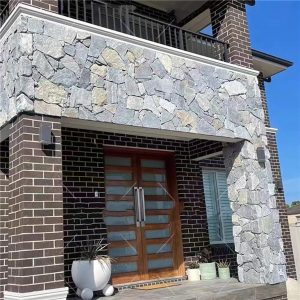Exploring the Durability of Cultured Stone A Comprehensive Analysis
Introduction: Cultured stone, also known as manufactured stone or faux stone, has become increasingly popular in the construction industry due to its versatility, aesthetics, and cost-effectiveness. While natural stone has long been favored for its durability, cultured stone offers a more affordable alternative that replicates the look and feel of natural stone. However, questions have been raised about the durability of cultured stone compared to its natural counterpart. In veneer stone , we will delve into the various factors that affect the durability of cultured stone, including its composition, installation methods, maintenance requirements, and long-term performance. Composition of Cultured Stone: Cultured stone is typically made from a mixture of cement, aggregates, and iron oxide pigments, which are molded and colored to resemble natural stone. This composition gives cultured stone its distinctive appearance while also providing some level of durability. However, the quality of the materials used in the manufacturing process can vary significantly among different brands and manufacturers, which can impact the overall durability of the final product. It is important for builders and homeowners to choose a reputable brand that uses high-quality materials to ensure the longevity of the cultured stone. Installation Methods: The durability of cultured stone is heavily dependent on the installation methods employed. Improper installation can lead to structural issues, water infiltration, and premature wear and tear. It is crucial that cultured stone is installed by experienced professionals who follow the manufacturer's guidelines and best practices. Proper installation techniques include preparing the substrate, applying the appropriate adhesive or mortar, ensuring proper drainage and ventilation, and sealing the stone to protect it from the elements. By adhering to these guidelines, builders can enhance the durability of cultured stone and prevent common issues that may arise over time. Maintenance Requirements: Like any building material, cultured stone requires regular maintenance to ensure its durability and longevity. Proper maintenance practices include cleaning the stone regularly to remove dirt, debris, and other contaminants that can degrade its appearance and performance. It is important to use mild, non-abrasive cleaners and avoid harsh chemicals that can damage the stone's finish. Additionally, inspecting the stone for any signs of damage, such as cracks, chips, or discoloration, and addressing these issues promptly can help prevent further deterioration and extend the lifespan of the cultured stone. Durability Testing: To assess the durability of cultured stone, various tests can be conducted to evaluate its resistance to weathering, impact, abrasion, and other factors that can affect its performance over time. Weathering tests expose the stone to simulated environmental conditions, such as temperature fluctuations, moisture, and UV radiation, to determine how well it withstands these elements. Impact tests assess the stone's ability to resist physical impact and structural damage, while abrasion tests measure its resistance to wear and tear from foot traffic, furniture, and other sources of friction. By subjecting cultured stone to these tests, manufacturers and builders can gain valuable insights into its durability and make informed decisions about its suitability for different applications. Long-Term Performance: The long-term performance of cultured stone is influenced by a combination of factors, including its composition, installation quality, maintenance practices, and environmental conditions. Properly installed and maintained cultured stone can last for decades without significant deterioration, providing a durable and aesthetically pleasing façade for residential and commercial buildings. However, exposure to harsh weather, poor installation, lack of maintenance, and other factors can compromise the durability of cultured stone and lead to premature failure. By considering these factors and taking proactive measures to protect and preserve the stone, builders can ensure its longevity and enhance the overall durability of their structures.  Conclusion: Cultured stone offers a durable and cost-effective alternative to natural stone for a wide range of construction applications. By understanding the factors that influence the durability of cultured stone, including its composition, installation methods, maintenance requirements, and long-term performance, builders and homeowners can make informed decisions about its use in their projects. With proper care and attention, cultured stone can provide a beautiful and long-lasting finish that enhances the aesthetic appeal and value of any building. By following best practices and investing in high-quality materials and installation, the durability of cultured stone can be maximized, ensuring its continued success in the construction industry for years to come.
Conclusion: Cultured stone offers a durable and cost-effective alternative to natural stone for a wide range of construction applications. By understanding the factors that influence the durability of cultured stone, including its composition, installation methods, maintenance requirements, and long-term performance, builders and homeowners can make informed decisions about its use in their projects. With proper care and attention, cultured stone can provide a beautiful and long-lasting finish that enhances the aesthetic appeal and value of any building. By following best practices and investing in high-quality materials and installation, the durability of cultured stone can be maximized, ensuring its continued success in the construction industry for years to come.